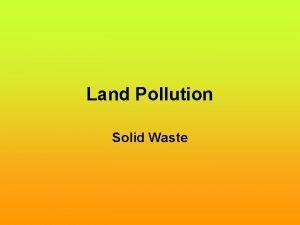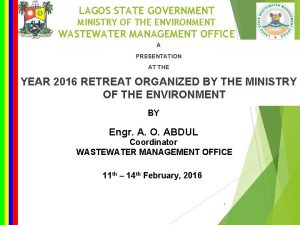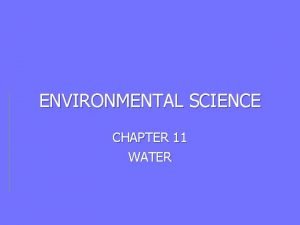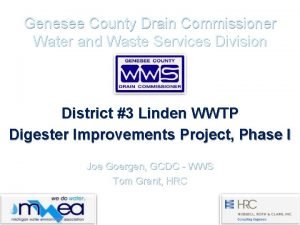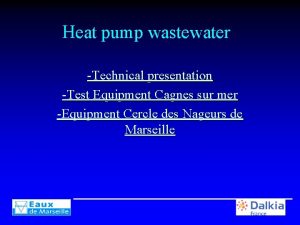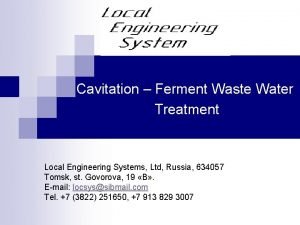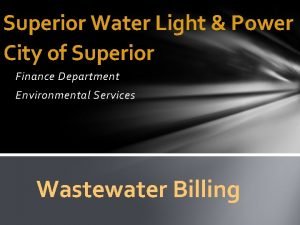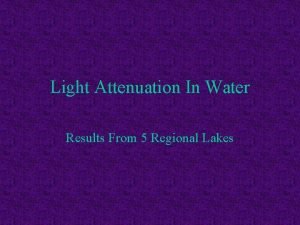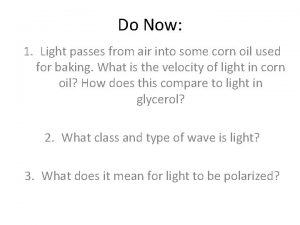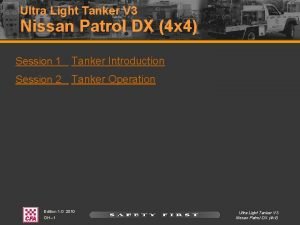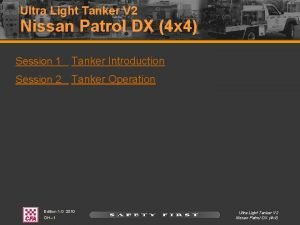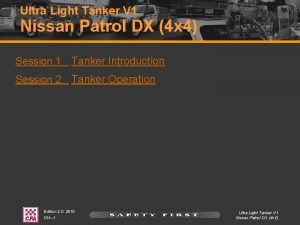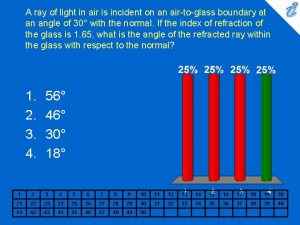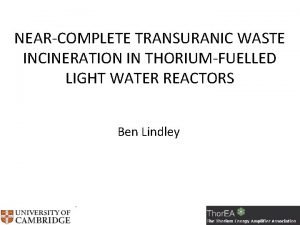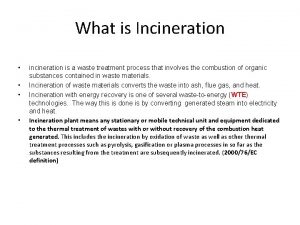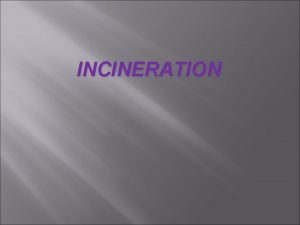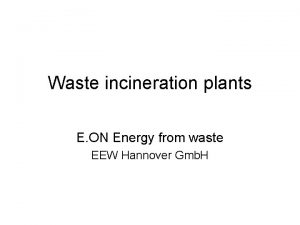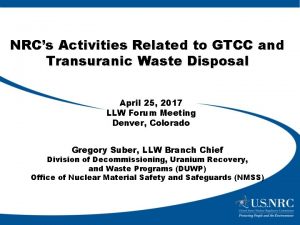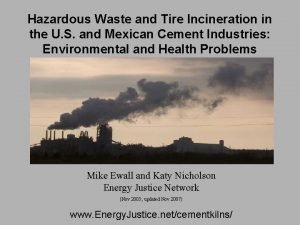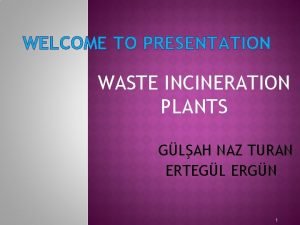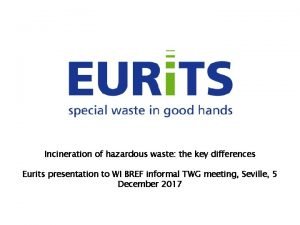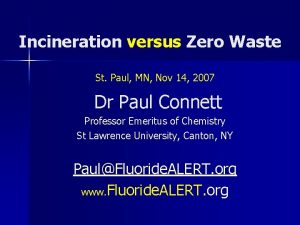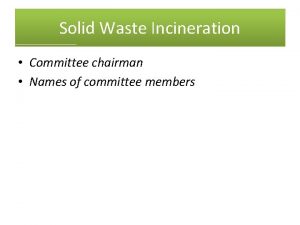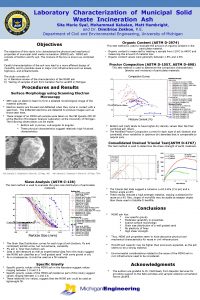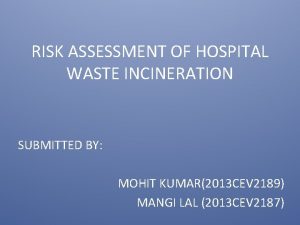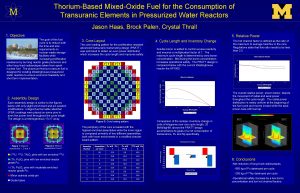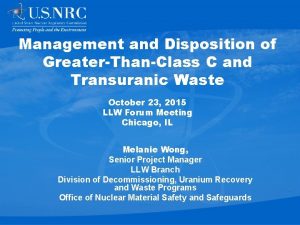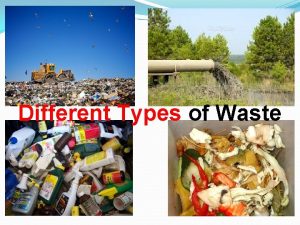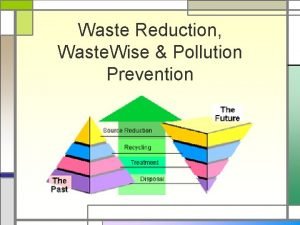NEARCOMPLETE TRANSURANIC WASTE INCINERATION IN THORIUMFUELLED LIGHT WATER
























- Slides: 24

NEAR-COMPLETE TRANSURANIC WASTE INCINERATION IN THORIUM-FUELLED LIGHT WATER REACTORS Ben Lindley

BACKGROUND • In ADSRs, transuranic (TRU) waste added to reactor with thorium. • At end of fuel cycle, reprocessed and U-233 removed. Addition thorium and TRUs added • Most waste is ultimately incinerated, but there is always some left as the isotope populations tend to equilibrium

LIGHT WATER REACTORS • U/Pu MOX allows limited recycle • 50 -75% destruction is possible using Th/Pu MOX* *Shwageraus et al. , 1995

METHOD • In this study, Th/ dirty Pu MOX is considered in a Generation III+ PWR • The TRUs are returned to the reactor after reprocessing • The U-233 is also returned to the reactor • Reloading parameters selected to give appropriate enrichments and burn-up (so note that all results are examples and ‘actual’ design may change the numbers) • One batch fuel strategy assumed (e. g. 4 batch burn~60% higher)

METHOD (2) • Analysis of single assembly performed using commercial reactor physics code WIMS 9 • Model benchmarked against MCNP calculation • Model and nuclear data library checked using IAEA benchmark

INCINERATION PERFORMANCE • Waste becomes less reactive over time in a thermal reactor. • “A fast neutron stage in the reactor appears… almost a necessity” (Rubbia et al. , 1995)

PU AND U

MINOR ACTINIDES

BURN-UP

REACTOR BEHAVIOUR • • U-233 provides required excess reactivity Faster neutron spectrum than with U-235/U-238 fuel Self shielding encourages equilibrium behaviour Fuel loaded with additional MAs can also be incinerated • Incineration tends towards ~250 kg/GWth yr (compared to 280 kg/GWth yr in ADSR)* *Rubbia et al. , 1995

PU AND U-233

MINOR ACTINIDES

REACTIVITY COEFFICIENTS • • Doppler coefficient (doesn’t change much) Void coefficient Moderator temperature coefficient 100% void coefficient

REACTIVITY COEFFICIENTS

REACTIVITY COEFFICIENTS (2)

IS A POSITIVE 100% VOID COEFFICIENT ACCEPTABLE? • In PWRs, high void fractions without emergency shutdown seems implausible • In BWRs, the void fraction at the top of the core can be 70 -80% • A negative 100% void coefficient is easier to achieve in a PWR • PWR appears preferable

REACTIVITY CONTROL • Soluble boron worth is much less • Change in reactivity over cycle is also much less (no depletion of U-235; after a large number of cycles poisoning isotopes such as Pu-240 are depleted over the cycle) • Result: little change

RELATIVE SOLUBLE BORON REQUIRED

REACTIVITY CONTROL • If coolant boils/expands amount of boron in the core is reduced • Fast neutron spectrum as coolant boils reduces boron capture cross section • Soluble boron makes the reactivity coefficients worse

MAXIMUM VS REQUIRED BORON

ALTERNATIVE CONTROL METHODS • Control rods • Burnable poisons

WHAT ELSE NEEDS CHECKING? • Reactor kinetics are different (worse than U-235/U 238) • Practicality of multiple reprocessing (also a problem for ADSR) • How much dirty Pu can be loaded in the core? (worse than ADSR) • Can the U-232 be handled and reside in the core without too much damage?

ADDITIONAL WORK • Reduced-Moderation PWR – Improved burn-up per % Pu enrichment – E. g. <16 wt% dirty Pu, 60 GWd/te 4 batch burn-up • Reduced-Moderation BWR (High Conversion) – Extensive research programme in Japan – Aim to limit TRU loading – Thorium is useful alternative to U/Pu for stability reasons – Strategic alternative to LMFBR or GFR?

CONCLUSIONS • A Generation III+ reactor can be used to achieve approaching 100% TRU incineration – – Competitive or improved burn-ups Stable Controllable Thermal-hydraulics are compatible • Low cost, low risk: new reactor designs, coolant technology and accelerator technology not required • Commercial implementation in medium term?
 Incineration of food waste
Incineration of food waste Cons of incineration
Cons of incineration Disadvantages of incineration
Disadvantages of incineration Water and water and water water
Water and water and water water Light light light chapter 23
Light light light chapter 23 Into the light chapter 22
Into the light chapter 22 Chapter 22
Chapter 22 Lagos state wastewater management office
Lagos state wastewater management office Objectives of water pollution
Objectives of water pollution Genesee county water and waste
Genesee county water and waste Spiral exchanger
Spiral exchanger Water waste
Water waste Put out the light othello
Put out the light othello Distinguish between photosystem 1 and photosystem 2
Distinguish between photosystem 1 and photosystem 2 Or the bending of light and the bouncing off of light
Or the bending of light and the bouncing off of light Which materials let light through
Which materials let light through Dantance
Dantance Light attenuation in water
Light attenuation in water What happens when light passes from air into water
What happens when light passes from air into water Light tanker for supplying water
Light tanker for supplying water Light tanker for supplying water or fuel
Light tanker for supplying water or fuel Light tanker for supplying water or fuel
Light tanker for supplying water or fuel A light beam in air is incident upon a still water surface
A light beam in air is incident upon a still water surface Drinking fountain
Drinking fountain Cara menghitung air tawar di kapal
Cara menghitung air tawar di kapal

